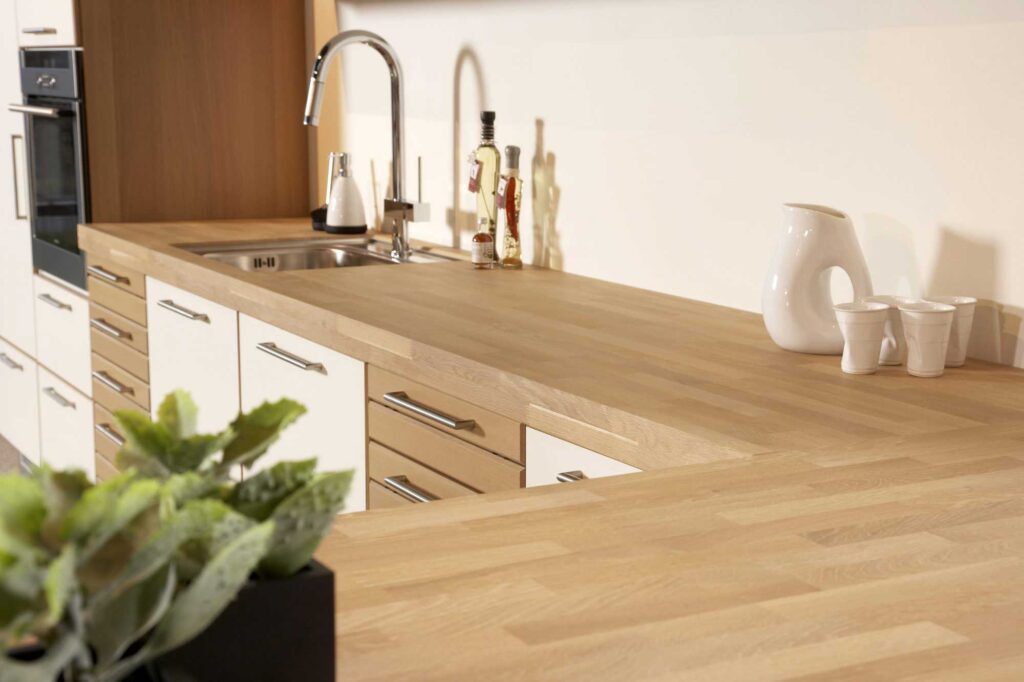Introduction
Few materials bring the warmth, character, and natural beauty to a kitchen quite like solid wood. As the heart of the home, your kitchen deserves surfaces that not only perform exceptionally but also create an inviting atmosphere where family and friends naturally gather.
Wood worktops have graced kitchens for centuries, and their enduring popularity speaks volumes about their unique combination of practicality, durability, and aesthetic appeal. Whether you’re planning a traditional country kitchen or a sleek contemporary space, understanding the benefits and care requirements of wooden surfaces will help you make an informed decision that enhances your home for decades to come.
Why Choose Solid Wood for Your Kitchen?
Natural Beauty That Ages Gracefully
Unlike synthetic materials that can look dated within a few years, wood possesses a timeless quality that improves with age. Each plank tells its own story through unique grain patterns, natural color variations, and subtle imperfections that add character rather than detract from beauty. This organic authenticity creates kitchens with genuine soul and warmth.
Solid Wood Worktops offer unparalleled versatility in design, complementing everything from rustic farmhouse styles to minimalist Scandinavian aesthetics. The natural tones work harmoniously with virtually any cabinet color, backsplash material, or flooring choice, making wood an incredibly forgiving design element.
Sustainability and Environmental Benefits
For environmentally conscious homeowners, wood represents one of the most sustainable worktop choices available. As a renewable resource, responsibly sourced timber from managed forests actually contributes to environmental health. Look for FSC (Forest Stewardship Council) certification to ensure your worktop comes from sustainable sources.
Wood also requires less energy-intensive processing compared to manufactured materials like quartz or porcelain. At the end of its long life, wooden worktops can be recycled, repurposed, or will biodegrade naturally, unlike synthetic alternatives that persist in landfills indefinitely.
Popular Wood Species and Their Characteristics
Oak: The Classic Choice
Oak remains the most popular choice for kitchen worktops, prized for its exceptional durability and distinctive grain pattern. Available in both European and American varieties, oak offers excellent resistance to wear and impact. Its medium hardness strikes an ideal balance—tough enough for daily kitchen demands yet soft enough to be forgiving on dropped glasses and dishes.
The warm, golden tones of oak deepen beautifully over time, developing a rich patina that enhances its character. This natural aging process means your worktop becomes more beautiful with each passing year.
Walnut: Sophisticated Elegance
For those seeking dramatic visual impact, walnut delivers with its rich, chocolate-brown tones and striking grain patterns. This premium hardwood brings instant sophistication to any kitchen, creating stunning focal points that elevate the entire space.
Walnut’s fine texture and smooth finish make it particularly pleasant to work on, while its natural oils provide some inherent water resistance. Though softer than oak, walnut remains perfectly suitable for kitchen use with appropriate care and maintenance.
Beech and Maple: Light and Contemporary
Lighter wood species like beech and maple suit modern, airy kitchen designs. Their pale, consistent coloring helps smaller kitchens feel more spacious while providing a neutral backdrop that won’t compete with colorful accessories or statement pieces.
These hardwoods offer excellent durability and fine, even grain patterns that create smooth, uniform surfaces. Their subtle beauty allows other design elements to shine while still contributing warmth and natural texture.
Essential Care and Maintenance
Initial Treatment and Regular Oiling
Proper maintenance begins before your worktop sees its first use. Most wooden surfaces require an initial treatment with food-safe oil to seal the wood and enhance its water resistance. Danish oil, tung oil, or specially formulated worktop oils penetrate deeply, protecting from within.
Regular oiling maintains this protective barrier—typically every few months for heavily used areas, less frequently for sections that see lighter use. This simple maintenance task takes minimal time but significantly extends your worktop’s lifespan while keeping it looking magnificent.
Daily Care and Cleaning
Wooden worktops thrive with straightforward care routines. Wipe up spills promptly to prevent water penetration, particularly near sinks and around taps where moisture exposure is highest. For daily cleaning, a damp cloth with mild soap suffices—avoid harsh chemical cleaners that can strip the wood’s protective oils.
Always use chopping boards to prevent knife marks, and never place hot pans directly on the surface. Trivets and heat pads protect against thermal damage while requiring minimal effort to use consistently.
Addressing Wear and Damage
One of wood’s greatest advantages is its remarkable ability to be refreshed and restored. Unlike manufactured surfaces where damage is permanent, wooden worktops can be sanded down to remove scratches, stains, and worn areas, revealing fresh timber beneath.
Minor scratches often buff out with light sanding and re-oiling. More significant damage may require professional restoration, but even deeply worn worktops can be brought back to near-original condition—a sustainable benefit that manufactured materials simply cannot match.
Practical Considerations for Different Kitchen Zones
Around the Sink Area
The area surrounding your kitchen sink faces the most challenging conditions—constant moisture exposure, soap, and temperature fluctuations. While wood can absolutely be used here successfully, it requires diligent maintenance. Ensure this zone receives the most frequent oiling, and consider applying additional coats to create robust water resistance.
Some homeowners opt for alternative materials directly around the sink while using wood elsewhere, creating practical hybrid solutions that maximize wood’s benefits while minimizing maintenance demands in the most vulnerable areas.
Preparation and Cooking Zones
Wood excels in food preparation areas, providing a naturally antibacterial surface that’s gentler on knife edges than stone or laminate. The slight give in wooden surfaces makes extended prep work more comfortable, reducing strain on wrists and arms during lengthy cooking sessions.
Position your main preparation area away from direct heat sources like hobs and ovens when possible. While wood can withstand typical kitchen temperatures, prolonged exposure to extreme heat can cause damage or premature aging.
Design Integration and Styling
Creating Visual Harmony
Wooden worktops serve as anchoring elements that tie together disparate design components. Their neutral, natural tones create bridges between contrasting colors, textures, and materials throughout your kitchen. This unifying quality makes wood particularly valuable in open-plan spaces where the kitchen flows into dining or living areas.
Consider how your chosen wood species interacts with existing elements. Cool-toned woods like ash complement white and gray color schemes, while warm oaks and walnuts enhance cream, beige, and earth-toned palettes.
Mixed Material Approaches
Contemporary kitchen design often embraces mixed materials, combining different worktop surfaces within the same space. Wood pairs beautifully with stone, concrete, or stainless steel, creating visual interest and practical functionality. Perhaps wood forms the main preparation surface while stone surrounds the hob, or wooden breakfast bars extend from laminate work areas.
These thoughtful combinations allow you to enjoy wood’s aesthetic and tactile benefits where they matter most while using alternative materials in high-stress zones, optimizing both form and function.
Cost Considerations and Investment Value
Understanding Price Ranges
Solid wood worktops span a broad price spectrum depending on species, thickness, grain type, and finishing. Common species like oak and beech offer excellent value, delivering premium appearance and performance at moderate costs. Exotic or particularly wide boards command higher prices but create showstopping visual impact.
When comparing costs, factor in wood’s longevity and restoration potential. A wooden worktop that can be refinished multiple times offers better lifetime value than cheaper alternatives requiring complete replacement when damaged or dated.
Return on Investment
Quality wooden worktops enhance property appeal and can positively influence resale values. Potential buyers consistently respond well to natural materials, perceiving them as premium features that justify higher asking prices. The timeless nature of wood means it won’t date your kitchen as quickly as trendy synthetic surfaces might.
Beyond financial returns, consider the daily enjoyment value. The tactile pleasure of working on natural wood, the way it warms your kitchen’s atmosphere, and the satisfaction of owning something genuinely beautiful contribute to quality of life in ways that transcend pure economics.
Frequently Asked Questions
Are wood worktops hygienic for food preparation?
Yes, wood worktops are naturally hygienic when properly maintained. Research shows that wood possesses inherent antibacterial properties—bacteria that penetrate the surface actually die off rather than multiply. Regular cleaning and oiling maintain these hygienic qualities, making wood perfectly safe for food preparation areas.
How long do solid wood worktops last?
With appropriate care and maintenance, solid wood worktops can last several decades. Many wooden surfaces in historic homes remain functional after 50-100 years. The ability to sand and refinish wood means it can be restored to like-new condition multiple times throughout its life, far outlasting many synthetic alternatives.
Can I place hot pans on wooden worktops?
It’s not recommended to place extremely hot pans directly on wood surfaces as this can cause scorch marks, discoloration, or thermal damage. Always use trivets, heat pads, or cooling racks to protect your worktop. This simple precaution takes seconds and prevents damage that might require refinishing to repair.
What’s the best wood for kitchen worktops?
Oak is widely considered the best all-around choice, offering excellent durability, beautiful grain patterns, and moderate pricing. However, “best” depends on your specific needs—walnut provides dramatic aesthetics, maple suits contemporary designs, and beech offers great value. Consider your budget, design preferences, and how much maintenance you’re comfortable performing.
How often should I oil my wood worktop?
New worktops typically need oiling every few weeks for the first few months to build up adequate protection. Once established, oil every 3-6 months depending on use intensity. Areas around sinks may need monthly attention, while less-used sections might only need annual treatment. The wood itself signals when it needs oiling—dry-looking or water-absorbing surfaces need treatment.
Conclusion
Solid wood worktops represent more than just functional kitchen surfaces—they’re investments in beauty, sustainability, and timeless design that enrich daily life. The natural warmth, authentic character, and remarkable longevity of wood create kitchens that feel genuinely welcoming while performing admirably under the demands of busy households.
While wood requires more maintenance than some synthetic alternatives, many homeowners find this care ritual satisfying—a mindful practice that deepens connection with their living space. The ability to restore and refinish wooden surfaces means your worktop can literally last a lifetime, aging gracefully alongside your family and home.
Whether you’re drawn to oak’s classic appeal, walnut’s sophisticated drama, or the clean lines of lighter woods, solid wood worktops offer unmatched versatility to realize your kitchen vision. By understanding proper care techniques and making informed species selections, you’ll enjoy surfaces that become more beautiful with every passing year—a rare quality in our disposable age.

